When I lived in downtown Seattle my entire apartment building shared a total of 2 washers, 2 dryers, and zero elevators.
This, combined with living on the third floor of a 100-year-old building with very high ceilings made laundry day a dreaded task. When one of the building’s washers tore my favorite shirt to shreds, it was the final straw. I set out to find a portable washing machine for doing laundry in my apartment.
I bought and returned 3 apartment sized portable washers before finding one that worked for me, in the years since, I’ve become a pro at helping friends hook up and troubleshoot their own portable washers. Here’s what I have to share from my experience:
- First, I explain how portable washing machines work:
- Then, I’ll show you 3 things to look for when purchasing a portable unit.
- You’ll learn 3 Hacks for installing a portable washer (the EASY way!)
- Plus some FAQ’s, tips on drying clothes in an apartment, and a pro hack for drying bathtub-washed clothes fast.
Read on to learn how to avoid the expensive mistakes I made shopping for my first apartment washing machine.
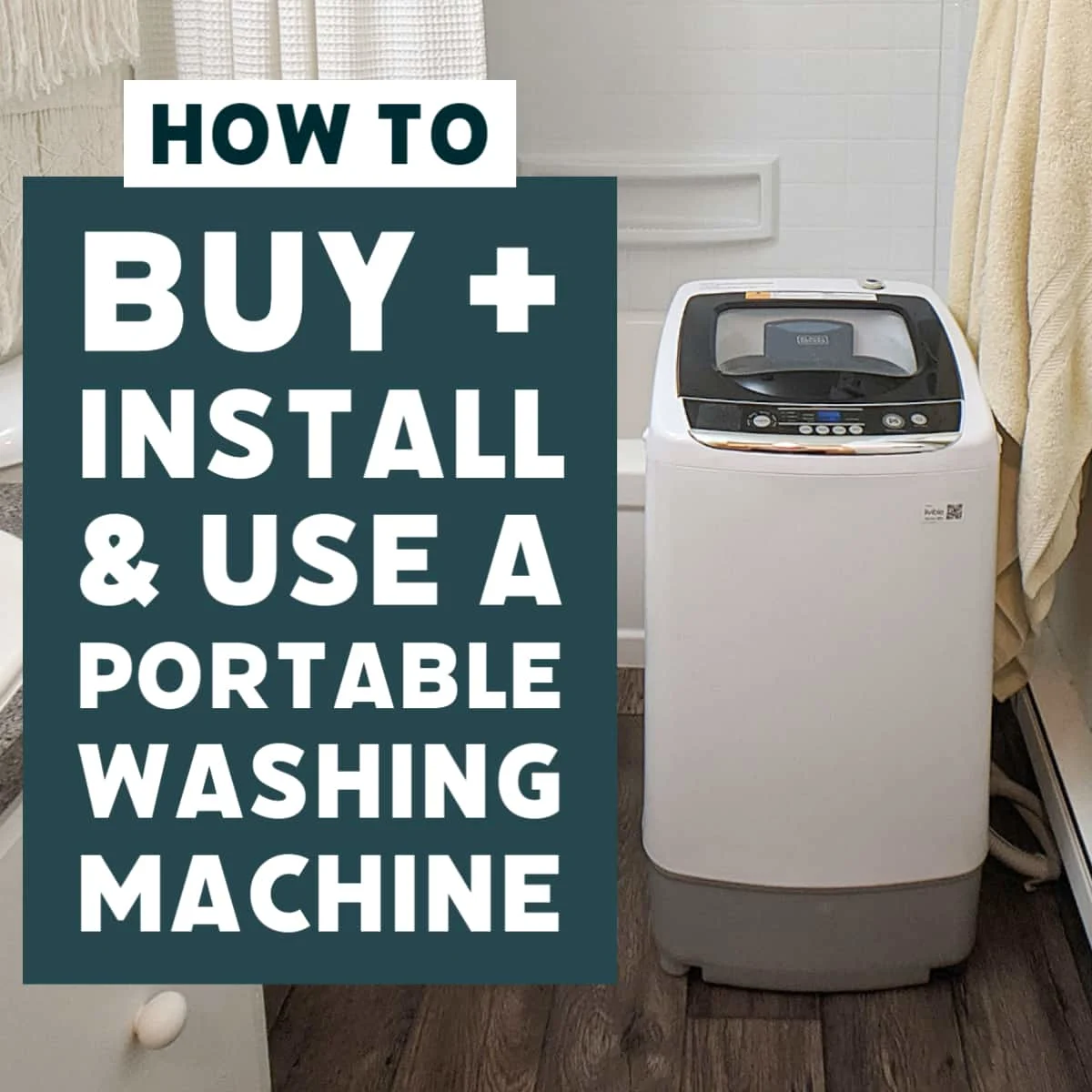
The following section may contain affiliate links. As an Amazon Associate, we earn from qualifying purchases.
With my original washer shopping motivated only by getting one at the lowest price, I ended up with an absolute garbage can of a washer. After replacing it with a Black and Decker model– with a bit higher price tag – I decided to write this article for other apartment, tiny home, or RV tenants researching portable washers.
First, Understanding how portable washing machines work:
Full-size washers are connected to existing plumbing and have a water inlet, where water enters, and a drain. Portable washing machines perform the same function but with temporary plumbing. These portable units have inlet valves with nozzles that fit onto a garden hose or shower head. They have a drain hose that can be placed into a sink, washtub, bathtub, or- if used outdoors- the ground!
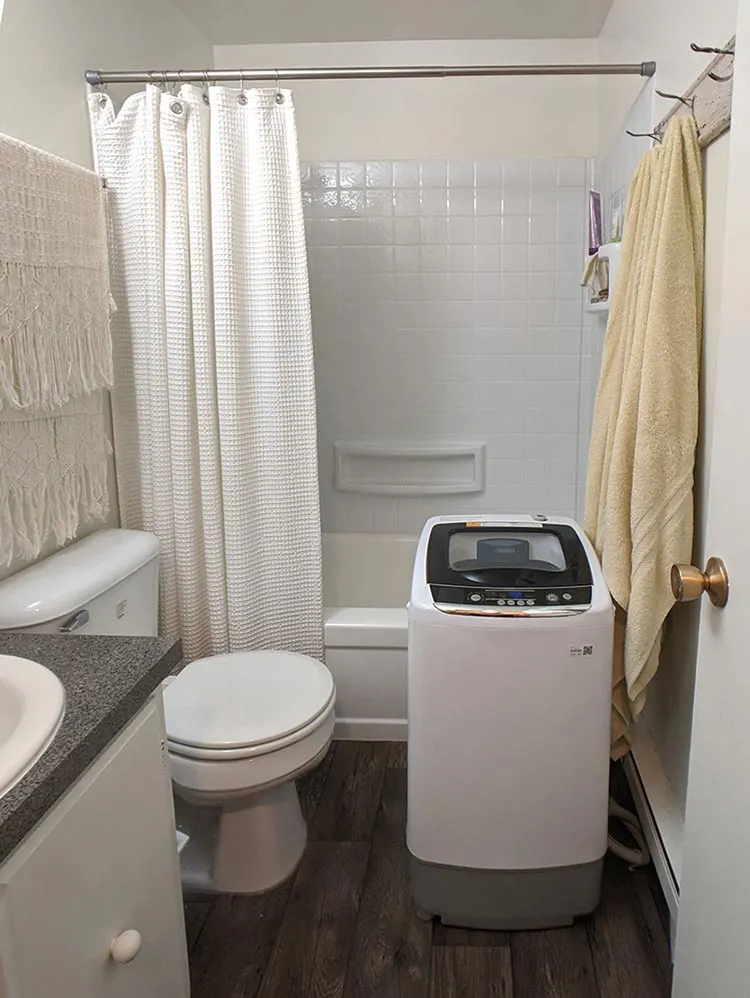
Things to look for when purchasing a portable washing machine:
After trying a few portable washing machines in my third-floor walk-up Seattle apartment, here’s my advice on what to look for in a mini clothes washer and why:
One drum or two?
Cheaper portable washing machines have side-by-side drums – one for washing and one for spinning the clothing dry. The user must manually lift heavy, dripping, water-saturated clothing from the washing drum into the spin drum. This is a very wet job as well as an extra task you’ll need to attend to manually. Higher-end portable washers- such as Black & Decker’s Portable Washing Machine combine this function into one drum, mimicking a typical wash cycle of a full-sized unit.
Before buying and trying a two drum washer, I didn’t realize that two-drum washing machines do not clean clothes as well because clothing enters the “rinse cycle” while still fully saturated with dirty water. To get clothing really clean, the user must move clothes to the spin drum, then back to the wash drum for a second wash. Using a double-cycle like this to get my clothes clean quickly burned out the motor on the Pyle portable washer I first purchased.
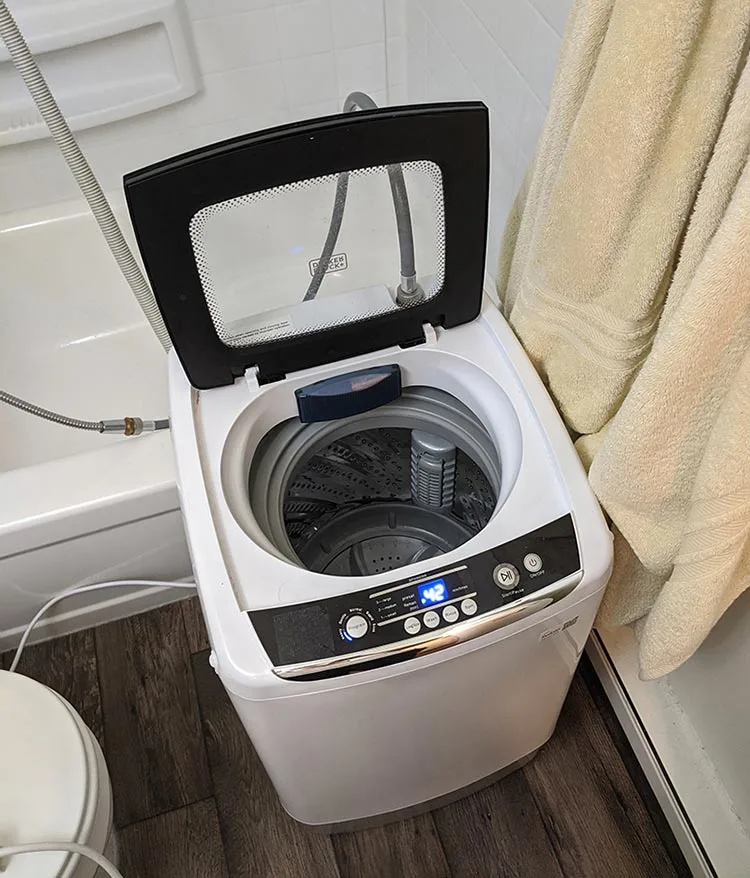
Inlet valve or manual fill?
Some portable washing machines require a manual filled for each wash or rinse phase of a wash cycle. These machines are only slightly easier than manual handwashing, as they require attention throughout the cycle and, most likely, a willingness to get a little wet. Good machines will have an inlet valve to which you can screw on a hose so the machine will automatically fill with the right amount of water at each phase of the cycle.
Gravity drain or pump drain?
Having used several portable washing machines, the most important feature to me is a pump drain. Pump drains work quickly to empty water from a hose at any angle, allowing a wash cycle to be completed sooner. Gravity drains empty very slowly and only work when the hose can be placed on a downward incline.
Hacks for installing a portable washer:
Follow your manufacturer’s instructions for installation as a primary guide, but these two modifications may help improve the function and ease-of-use for your machine:
1. Upgrade your shower to a handheld showerhead, then use the same hose for filling your washing machine.
Guys, this is a game-changer, an absolute essential, and the first modification I make to the shower in any apartment I move into: Swapping from a wall mount shower head to a handheld is so cheap and literally just takes three minutes and no tools.
The #1 handheld shower head at Amazon (which is the one pictured in this post) works great. Once you’ve upgraded to a handheld showerhead, the included hose makes it easy to connect to your washing machine whenever you need to wash a load of clothes.
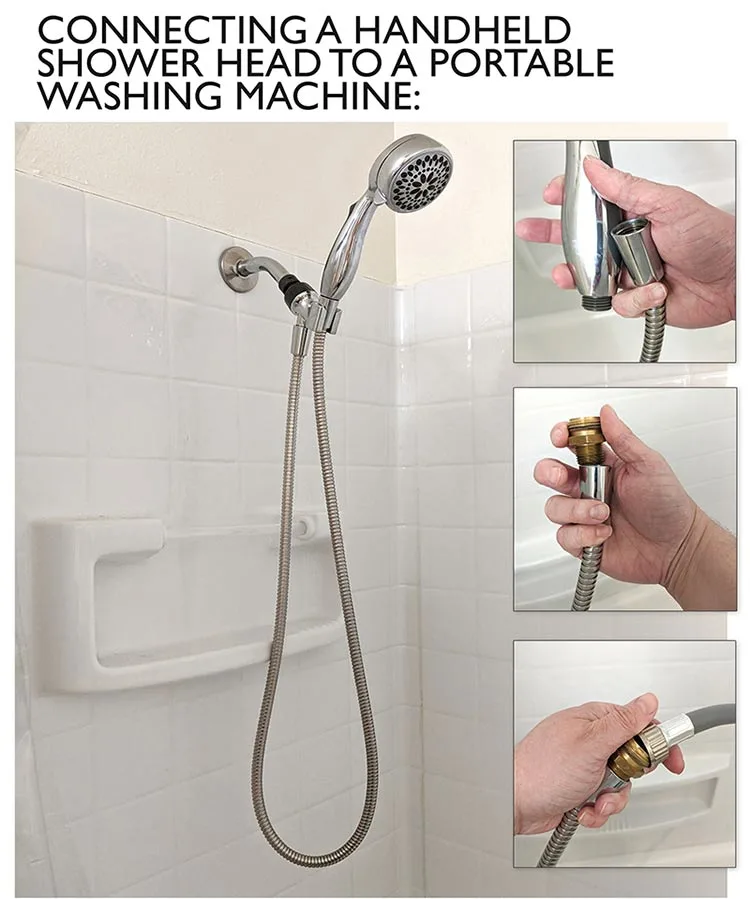
You’ll probably need to purchase an adapter to join the showerhead hose and the washer inlet. To connect a standard handheld shower hose to the vast majority of portable washers (they tend to be threaded for garden hose connections), you’ll need a 3/4″ MGH x 1/2″ MPT Adaptor (“MGH” means “male garden hose”, mpt = “male pipe thread”).
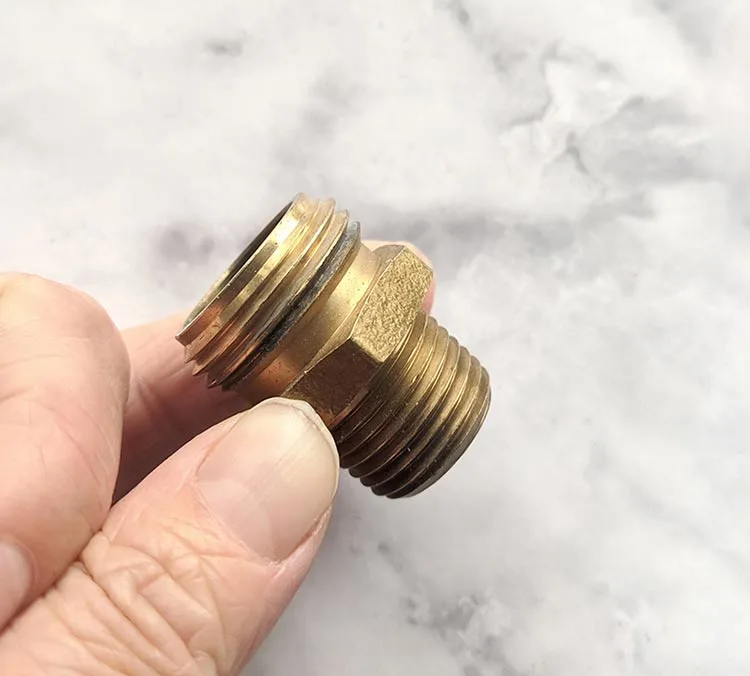
Buy a brass one at amazon via this link, or you might be able to find a plastic version at your local hardware store. (Amazon doesn’t seem to stock the plastic version, and big box home improvement stores almost definitely won’t carry this unusual pipe adaptor in any material).
2. Experiment with drain hose placement
Your mileage may vary depending on your washer model, but my Black & Decker washing machine functions much better when the drain hose is placed up high.
While gravity-draining models require the hose to be placed lower than the unit for best results, some pump-drain style washers need to be placed up high in order to prevent too much pressure on the valve.
If the hose is positioned low and the valve is weak, a high water level during a wash cycle could cause leaks.
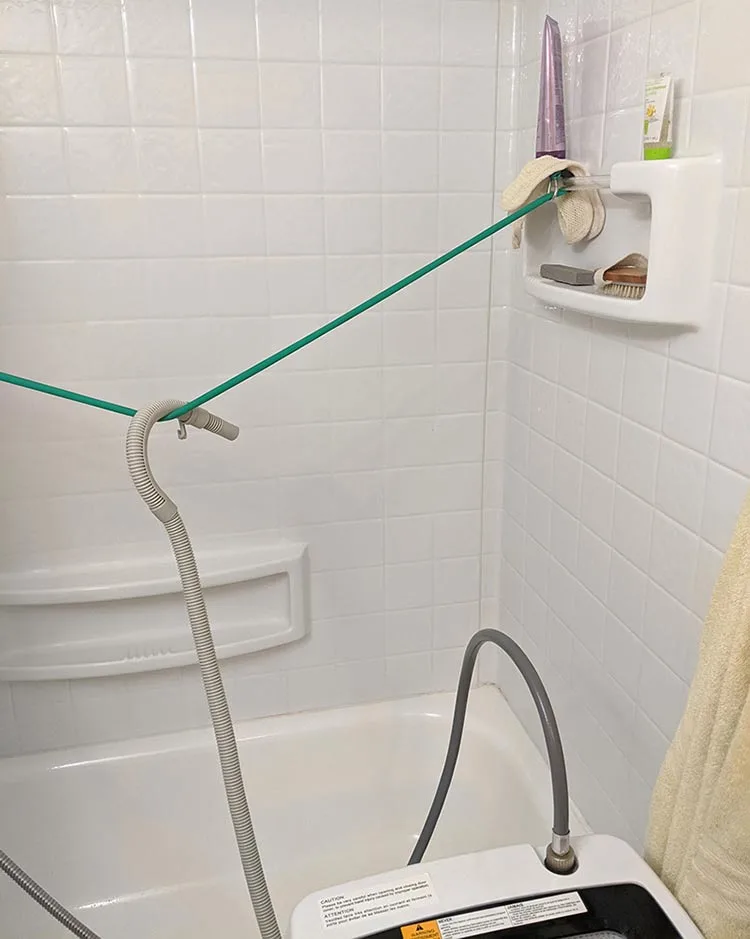
3. Invest in Water Alarms
Water + Homes = always tricky. Protect your investment or your rental deposit by using devices designed to alert you when water begins to pool where it shouldn’t (such as a misdirect drain hose emptying water onto a floor rather than a tub!).
Although there are wifi-based leak sensors that can send an alert to your phone when sensors detect water, if you’ll only have your washer connected when you are at home then an inexpensive water sensor that emits an alarm when wet should work.
For Drying Clothes:
TIP: Avoid purchasing a portable washing machine that claims to be a portable washer and dryer. Although full-size, standard-installation washer/dryer combination machines exist and work pretty well, machines advertised as “portable washer dryer combos” are usually very bad at both functions. Believe me, I tested a few and read hundreds of reviews. Portable “washer/dryers” lack a tumble feature or a heating element, and the only “drying” mechanism is an extended spin cycle- which any good portable washer will offer.
If I get a portable washer do I also need a portable dryer?
Definitely not! It’s uniquely North American to view a washer and dryer as an essential pairing. There are so many easy and energy-efficient ways to dry clothes without using a dryer (even in the winter) and it’s SO much better for your clothes!
Here are the dryer methods that I’ve used and liked. The perfect one for you will depend on your living situation and what you have access to:
Retractable clothesline
A retractable clothesline is the simplest and also the most aesthetically appealing option for drying clothes without a washer. I love this one so much that I’ve uninstalled, moved with it, and reinstalled it 3 times in the last 10 years! With a section mounted on each side of a room, the retractable clothesline allows you to pull the necessary length out and attach it to its counterpart across the room, creating a clothesline when you need it and free space when you don’t. Retractable clotheslines work best to dry clothes when installed in a bathroom with an exhaust fan.
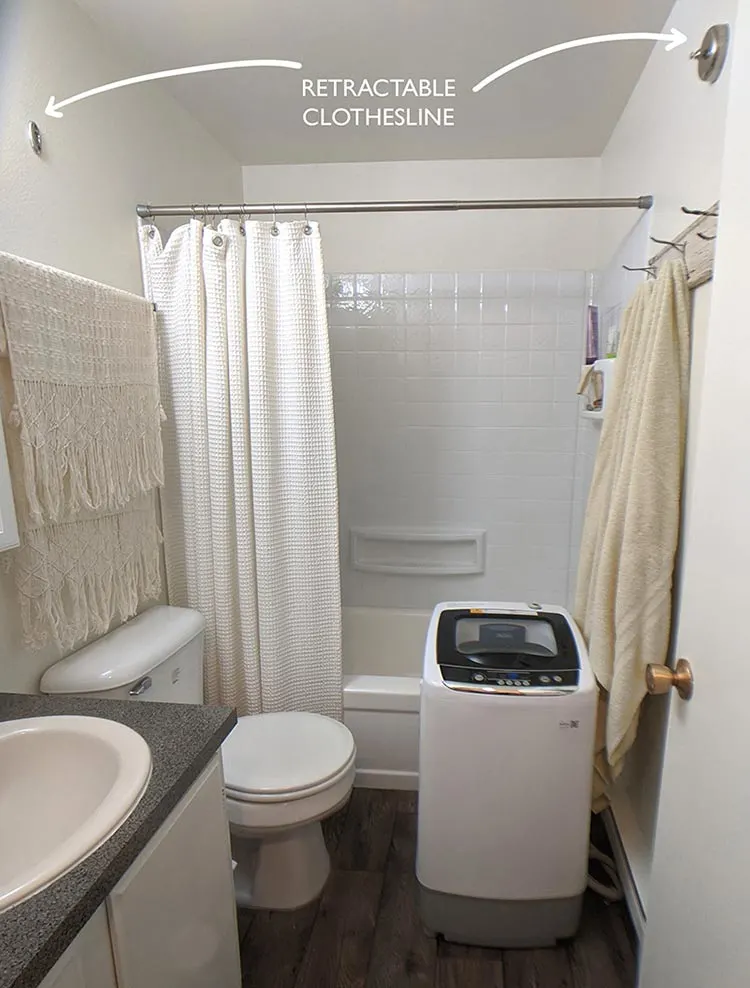
Travel clothesline
You guys have heard me talk about about Lewis N Clark products on my travel posts, but I love their travel clothesline. Tiny gaps in the stretchy braided cord allow it to be used without clothespins. Just tuck a tiny corner of the fabric into a gap and the tension will hold it secure. Surprisingly strong suction cups keep this mounted on a variety of surfaces. This model was my go-to when I spent three months in South America last year!
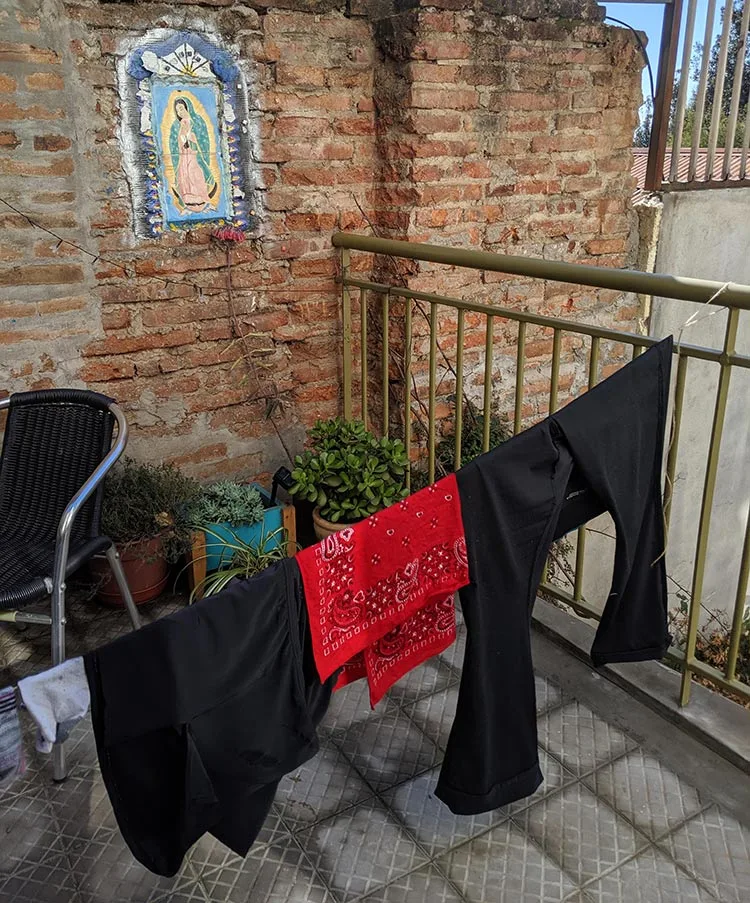
Pants Hanger
Pants hangers were very popular in decades past. Honestly all three of the pants hangers I own I purchased from vintage shops (you can get vintage ones like mine via these listings on Etsy)! They are ideal for small locations and for maximizing drying space. I also like that they aren’t single-use. They’re technically designed for hanging skirts but I love them for organizing scarves and accessories!
Another bonus of this style of drying rack is that the hanger is ideal for situations where you might need to dry clothing in an open window. The clips keep garments secured even in a strong breeze.
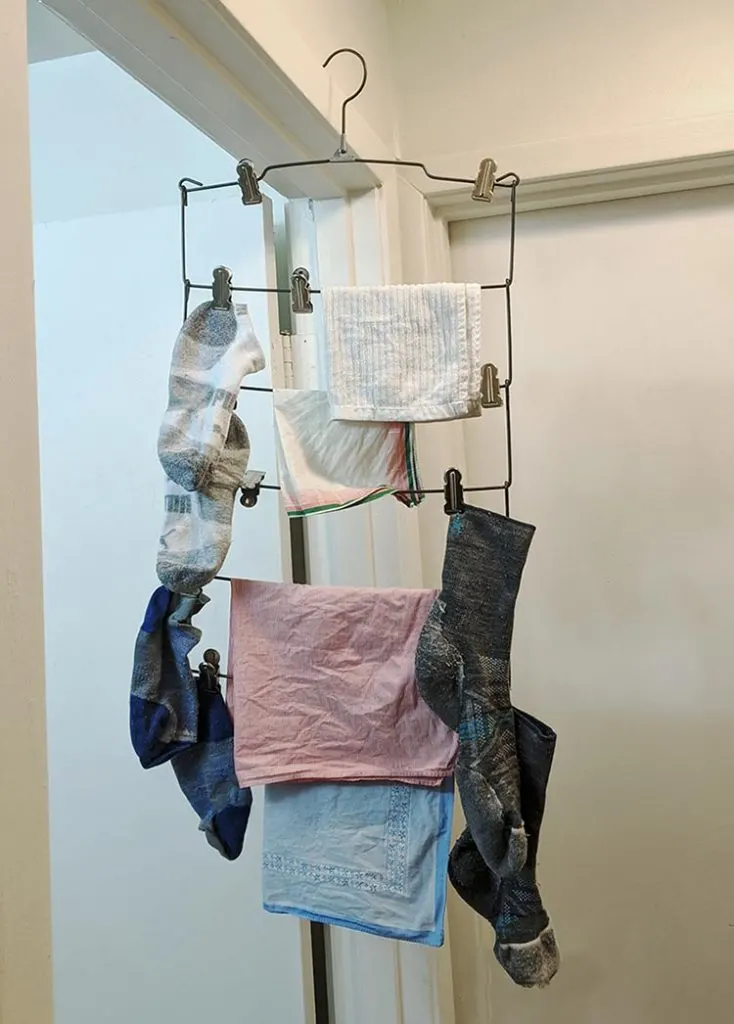
Dryer rack
Somewhat common and perhaps something you already own for drying sweaters, dryer racks take up a lot of floorspace when in use but have only a tiny footprint when folded up. They’re great for drying an entire load quickly. Because they’re portable, they can be used inside or outside.
How to avoid humidity when air drying clothes indoors.
The trick to drying clothes fresh from your portable washing machine without creating a swamp-like microclimate is ventilation. Consider how air is entering and exiting the room where you are drying clothing.
Keep humidity down by 1. exchanging wet air for dry by using a fan + open window or an exhaust fan, or 2. actively dehumidify the air by using a heater or a dehumidifier. Both strategies work well to keep your living space comfortable while drying clothes indoors. Here are a few tips:
- Manually adjust your wash cycle to force the machine to spin the load as long as the settings will allow.
- If using in a bathroom, turn on the exhaust fan
- If air outside is a tolerable temperature, open windows.
- Set up a fan blowing on the wet clothes
- Run a space heater in the area (heaters dehumidify air), a safe distance from flammable materials.
If you have a small bathroom, the combination of a space heater and a strong fan can dry clothes in just a bit more time than a conventional clothes dryer takes.
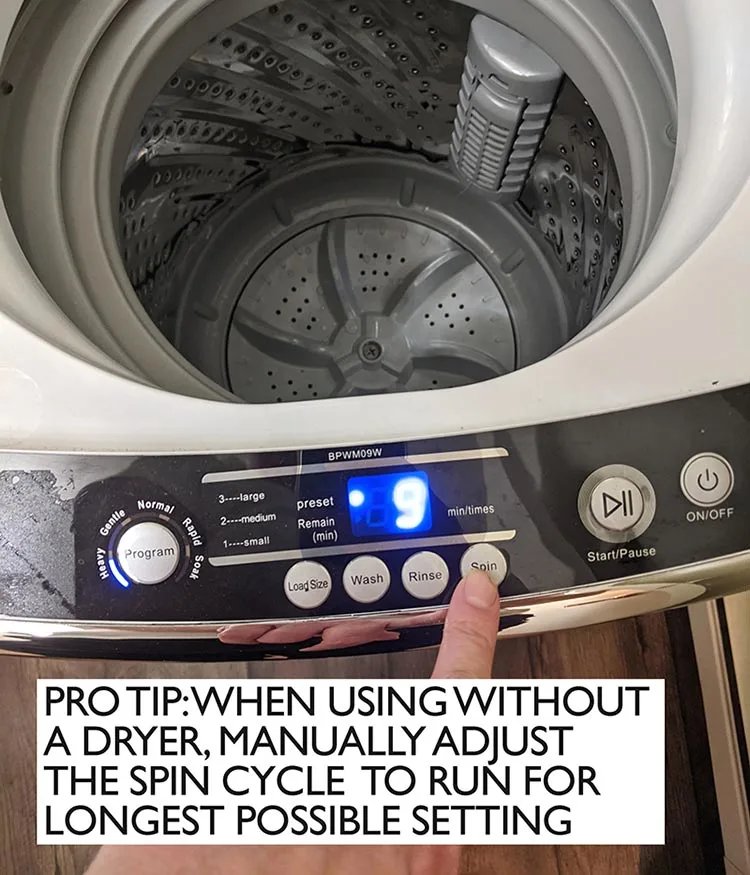
Need a reminder for later in your project? Pin the image below:
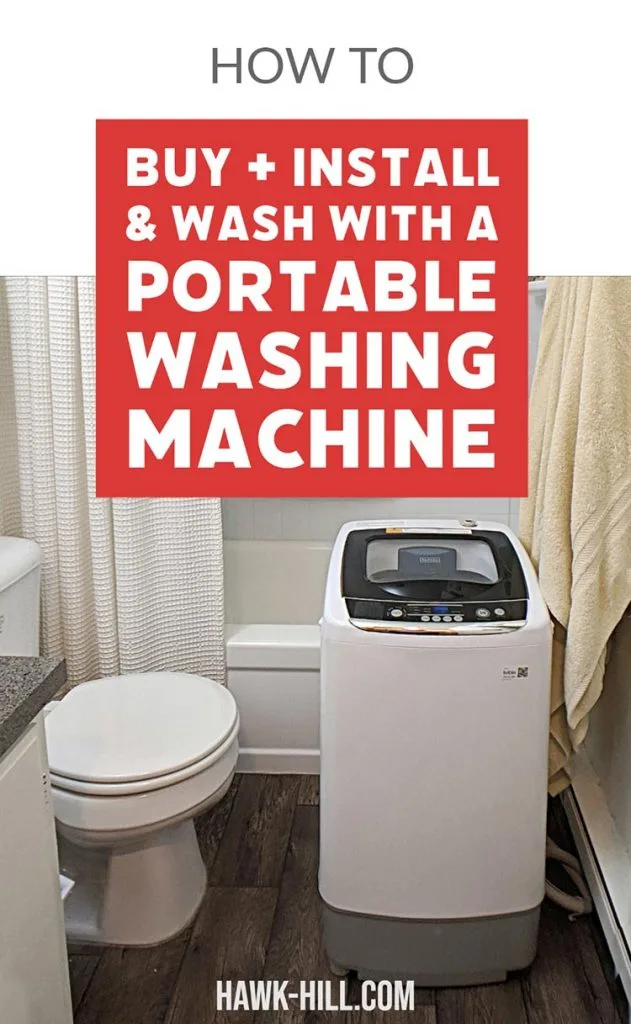
:]
Thanks for Reading!!!
I hope you can tell that I love DIY, researching the best affordable solutions for every-day problems opportunities and documenting / sharing solutions!🙌 Hawk-Hill.com is reader-supported.
☕ Hawk-Hill.com is reader-supported. If this article saved you time or money, please consider donating $1 to help me cover the cost of hosting this website OR If you appreciate this information and want to throw a “Thanks!” my way by buying me a coffee – I would Of Course appreciate it! :]
Reader Questions and Recommendations
Readers, do you have any favorite topics / posts? What would you like to read more about in the future? As I hope you can tell from this and other articles on my site, I really enjoy DIY / a good challenge, and I’m not afraid to roll up my sleeves to figure out a great, and hopefully simple 😁 solution. So please feel free to let me know in the comments below (or reach out via social media)!
Ok Really – I’ll try to wrap this up now😂
Finally, if you’d like to continue to learn about interesting DIY options as well as how YOU can tackle creative new projects consider checking out the latest and most popular articles listed on the Hawk-Hill Home Page. I’m always trying to enjoy and write about the creative side of life so please don’t be a stranger – check back often!😍
If you enjoyed this post you may also enjoy reading / perusing / devouring😊 one or all of these articles as well!
- 💡4 Easy Steps to Make Your Own Sea Glass 🌊
- ❤️Bedroom Decorating Ideas for Single Women’s Master Bedrooms 🛏️
- 🏡Ikea Kitchen Cost: What I Spent for a 9×12 Kitchen Remodel 💵
- 4 Easy Steps to Make Your Own Sea Glass
- Bedroom Decorating Ideas for Single Women’s Master Bedrooms
- How to Add a Plug to a Hardwired Light Fixture or Chandelier
FAQ’s
How do portable washing machines work?
Portable washing machines work just like standard clothes washers, with a few small differences.
Instead of connecting to a dedicated water inlet and drain, a portable washer fills via a temporary hookup to a faucet, showerhead, or hose. When the cycle is finished, the wash water drains into a bathtub, basin, or floor drain. Although some cheap units require manual fill and drain, a quality apartment washer runs a full cycle of soaking, agitating, and spinning dry a small load of clothing. Portable washing machines work well for many apartments, RVs, and tiny homes.
How do I clean a portable washing machine?
Cleaning a portable washer is not much different from cleaning a standard washing machine. From time to time, it may be helpful to run a load with a cup of hydrogen peroxide added (caution- this may whiten clothes). The hydrogen peroxide gently cleanses the drum and hoses without being too harsh on delicate parts.
Cleaning a portable washing machine includes clearing all filters. Check your owner’s manual, since many portable units have two different filters that catch lint and debris!
Keep your top loading portable washer working its best by completely draining the unit before putting it back into storage.
How to fix a portable washing machine?
Cheap portable washing machines are notorious for failing and being impossible to repair- the first portable washer I purchased died exactly 2 days beyond its 30-day warranty! If your mini clothes washer isn’t working properly, empty it, unplug it, and check for obstructions. Clear all filters (many portable washing machines have a filter located on the inside and a filter located on the exterior near the drain hose) and check the owner’s manual for troubleshooting advice.
If your portable washing machine still isn’t working, you don’t have to pay for an appliance repairman to make a home visit. You can just load it up and take it to an appliance repair shop.
Do portable washing machines really work?
Yes! I have a lot of experience handwashing clothing during international travel and while cheap nameless-brand portable washers don’t do much better than handwashing, good quality portable washing machines such as Black & Deckers do clean clothing equivalently to a standard washing machine.
Do portable washing machines use a lot of electricity or water?
Generally, portable washing machines use less water and electricity than typical washers. Because a typical washer is built to wash 12 to 16 pounds of laundry and a mini clothes washing machine has a capacity of about 5 to 7 pounds of laundry, the machine doesn’t have to work as hard or use as much water as a full-size washer. If you only need to wash a few garments, it’s much more energy-efficient to use a portable washing machine than to use a full cycle of a standard washing machine.
Is a portable washing machine worth it?
For me, a portable washing machine was the best investment I ever made in my apartment living lifestyle. It takes slightly more work than a typical washing machine because you might have to hook it up each time you use it. If your apartment building’s laundry facilities are safe and convenient or you don’t mind taking your clothes to a laundromat, a portable washer might not be worth it for you.

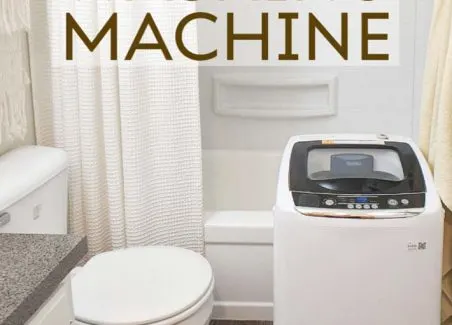
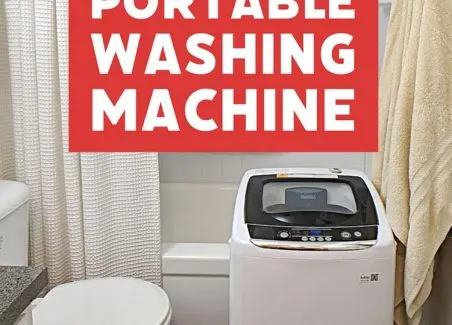
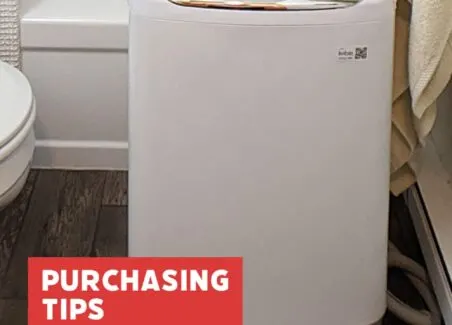
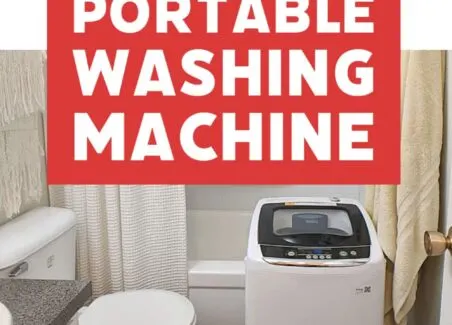
luxma
Wednesday 6th of September 2023
In the realm of household appliances, the portable washing machine stands as a testament to the ingenuity of modern engineering. This compact and versatile device has transformed the way people do laundry, offering convenience and flexibility like never before. Whether you live in a small apartment, a dormitory, a tiny house, or an RV, a portable washing machine can be a game-changer for your laundry needs.
Paige Jones
Monday 8th of May 2023
Hello, Could you please suggest a small Black and Decker that runs with hot water? With health issues I need to wash in hot water. We just moved into a small place and the laundrymat is not option here. Thank you for your time, Paige Jones
Paige Jones
Thursday 4th of May 2023
Hi, Thank you so much for the great article! You did so much research. Is there a small Black and Decker that uses hot water you recommend?
Paige Jones
Monday 8th of May 2023
@Lindsayanne Brenner, It says cold water only. I really need hot for health reasons. Is there anything else you would suggest? Thank you! Paige Jones
Lindsayanne Brenner
Thursday 4th of May 2023
Hi! I'm glad you liked the article. This is a small portable washer that I have been very impressed with and would recommend :] https://amzn.to/423bnLB
Serena Black
Wednesday 26th of April 2023
Hello how long did you black and decker machine last? Did you have any leaking problems? I live in an apartment! Thank you so much
Lindsayanne Brenner
Friday 28th of April 2023
Hi! Thanks for your comment, I had that champ of a Black & Decker unit until I moved away from the 3rd floor walk-up apartment (years) and it treated me very well the entire time. I highly recommend it for making apartment living as comfortable as possible. Cheers!
K Simms
Wednesday 5th of April 2023
When hooked up to shower head as you have recommended, can I get a hot water wash? If hooked up to kitchen faucet, are there hoses for both cold and hot taps? If not, how do I get a hot water wash? Thanks!
Lindsayanne Brenner
Thursday 6th of April 2023
Hi - Great question. Generally, you will have to hook up the water supply hose to the sink faucet or shower and manually set the faucet to hot, warm or cold water. It's great if you have a blended faucet (that has both the hot water and the cold water channel through the same faucet) so you don't have to attach and disconnect hoses to the water source...if they are two distinct faucets in the same sink. Hope this answer helps and thanks for reading!